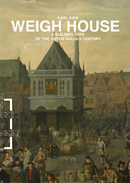Karl Kiem: Weigh House. A building type of the Dutch Golden Century [2017]
The monofunctional weigh house in Holland is an especially diverse and appropriate testament-in-stone to the socalled Golden Age of the Netherlands. Acknowledging these qualities, the weigh house can be considered an architectural equivalent of the Dutch painting of the seventeenth century.
The weigh house, a unique architectural typology, was integral to Dutch culture throughout the seventeenth and eighteenth centuries. This typology is almost exclusively found in the provinces of Holland and Friesland. It is not surprising that the most famous painters of this period resided in these two provinces, as these territories formed the economic and cultural center of the Republic of the United Netherlands. The weigh house developed into an independent architectural typology during the so-called Golden Century. Generally speaking, the weigh house can be seen as the architectural equivalent of Rembrandt and Vermeer’s artistic works.
Karl Kiem
THE WEIGH HOUSE. A building type of the Dutch Golden Century, 2nd edition
Siegen: universi 2019, 345 S., zahlreiche Abb. s/w, teils farbig
ISBN ISBN 978-3-9182-037-5
Preis: 35,50 Euro
Online-Version auf dem OPUS-Server der Universitätsbibliothek




